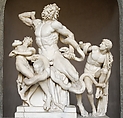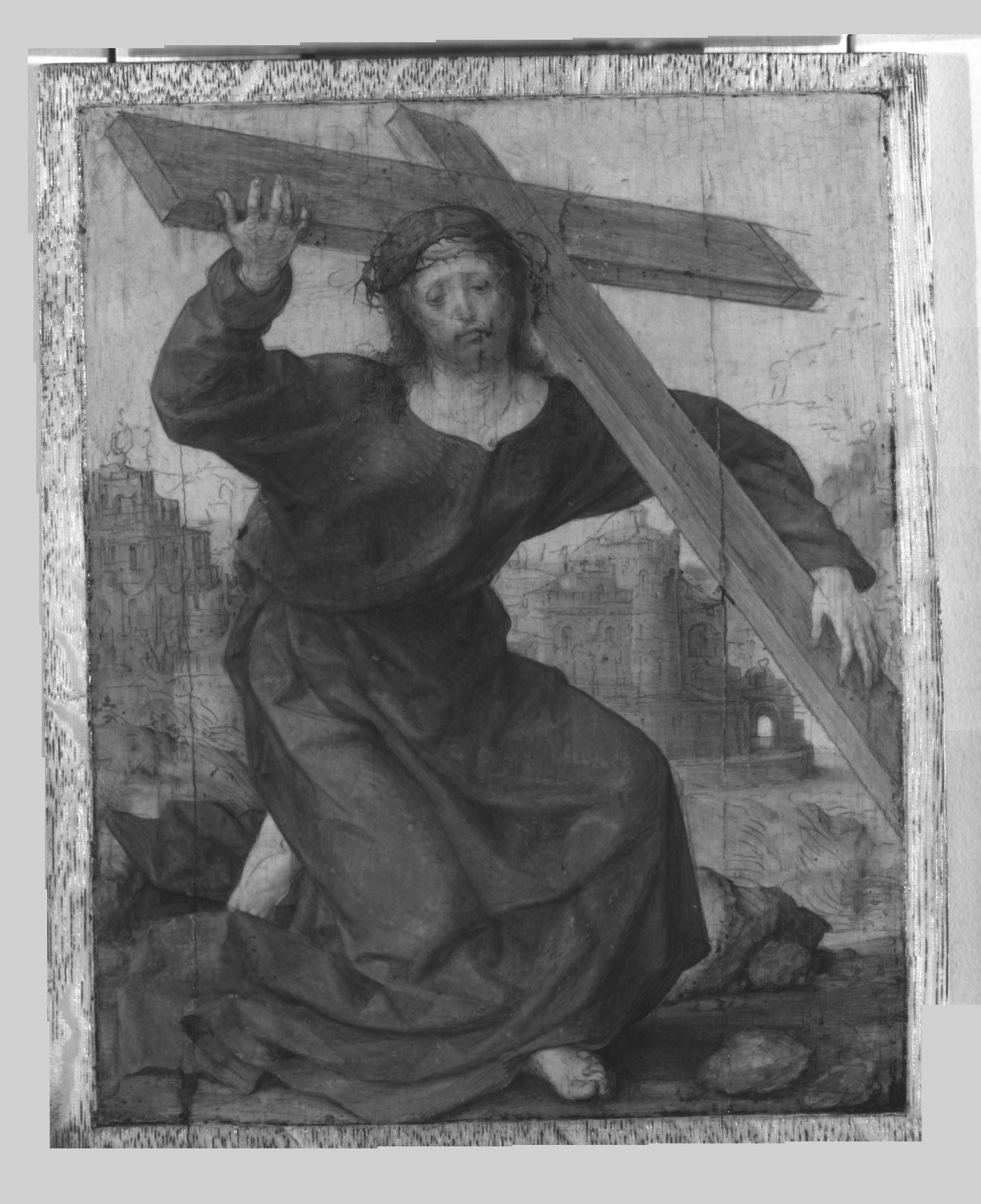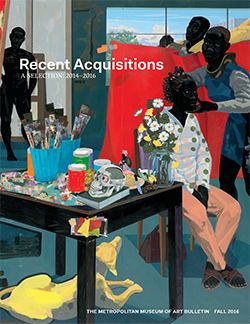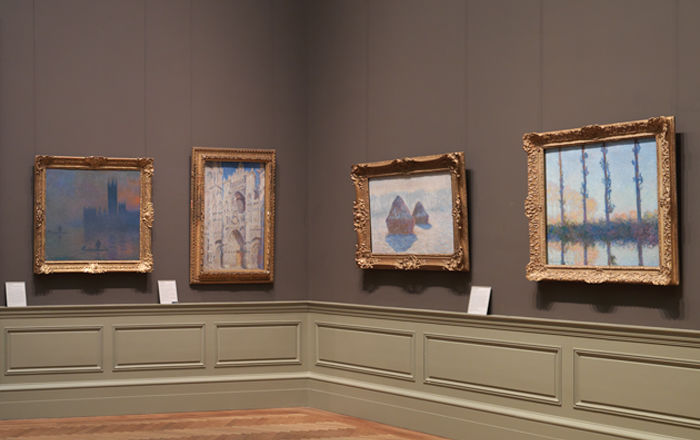The Artist: For a biography of Jan Gossart, see
Maryan W. Ainsworth, "Jan Gossart (ca. 1478–1532) and His Circle." In Heilbrunn Timeline of Art History. New York: The Metropolitan Museum of Art, 2000–.The Subject and the Function of the Painting: In this diminutive but emotionally compelling work, Christ stumbles under the heavy burden—both physical and psychological—of the cross that he bears en route to Golgatha, the site of his crucifixion. The Gospel of Saint John (19:17) is the only biblical text that describes Christ bearing this weight alone ("Carrying his own cross, he went out to the place of the Skull, which in Aramaic is called Golgotha"), while the other gospels mention Simon of Cyrene, who assisted him. Jesus is dressed in the purple robe and adorned with the crown of thorns that he was forced to wear when Pontius Pilate presented him to the people for judgment saying "Behold the Man" (
Ecce Homo). In the background, the cityscape features a temple and a palace with donjon that evoke the ancient city of Jerusalem. It appears nestled in a valley below the rocky precipice where Christ stands and the rising mountain slope in the distance at the right, barely visible in a soft atmospheric haze.
Unusual for Netherlandish paintings of this theme that are ordinarily replete with narrative detail, here there are no boisterous crowds accompanying Christ on his path to certain death. Absent are the Virgin, Saint John, and the three other attending Marys, as well as the two convicted thieves who would hang to the right and left of Christ on their own crosses. This excerpt from the traditional Passion narrative is intended for meditation focused on Jesus’s suffering during his Passion, and is linked with popular devotional texts, namely Thomas à Kempis’s
De Imitatione Christi (Imitation of Christ) of about 1420. Book Two, chapter 12, "On the Royal Road to the Holy Cross" begins with the well-known passage from the Gospel of Saint Matthew 16:24: "Deny yourself, take up your cross, and follow Me." The accompanying exegesis explains that the route to salvation is only through vicariously bearing the cross and dying with Jesus, and that by embracing his anguish, one shares his glory. The reader’s shared experience with Christ through self-denial and suffering thus is prompted by Gossart’s painting.
While it is possible that this small panel joined others representing the Stations of the Cross or a series devoted to Christ’s Passion that were framed together, no other small panels by Gossart have survived that could have been part of such a group. Perhaps the panel formed the left half of a diptych with a praying donor at the right. However, no ready candidate has survived in Gossart’s works for such a reconstruction, and the back of the panel is not painted as it would have been if it were part of a closing diptych. It is more likely that this small panel was framed individually and hung on a wall or was hand-held for private devotional practice.
Gossart’s Artistic Expression and the Painting within his Works: This little-known painting was only publically displayed twice in the last thirty years, once in 1983 at an exhibition at Colnaghi, New York, where it was catalogued by Ellen Konowitz and Egbert Haverkamp-Begemann as by Gossart (Konowitz 1983). The attribution was confirmed in the 2010 monographic exhibition on Gossart at The Metropolitan Museum of Art (Ainsworth 2010), where it was installed alongside other autograph works. Gossart presented Christ in isolated Passion scenes in several paintings and a print from the later part of his career. He portrayed Christ mocked in both a print of about 1525 and a painting of 1527 (Museum of Fine Arts, Boston, 1972.23; and Szépművészeti Múzeum, Budapest, 4362), and focused on Christ’s utter despair before the Crucifixion in
Christ on the Cold Stone of about 1530 (Real Colegio del Corpus Christi, Valencia, 094). All of these share Gossart’s keenly felt and poignant depiction of a dejected Christ, conveyed especially in the facial expression but also in the pose of the figure.
The complex pose of the figure derives from Gossart’s close study of classical sculpture encountered on his trip to Rome in 1508, along with his patron Philip of Burgundy on a diplomatic mission on behalf of Margaret of Austria, Regent of the Netherlands, to Pope Julius II. This experience led Gossart to infuse his works with a new sculptural approach, manifested in twisted, sometimes oddly foreshortened figures in contrasting poses, and often in curiously compressed spaces. Specifically, Gossart’s Christ calls to mind the famous
Laocoön and His Sons (see fig. 1 above) that had just been excavated in 1506, two years prior to the artist’s arrival in Rome, and was quickly acquired by Pope Julius II for his own collection where Gossart must have seen it. He no doubt understood the
Laocoön as epitomizing pain and sacrifice, thus serving as a model not only for its dynamic pose but also for its meaning.
Gossart’s Christ also recalls the Adam in his
Adam and Eve, a drawing of about 1520–25 (Albertina, Vienna, 13341). Both figures show a similar serpentine stance of the body, nearly impossible position of the right arm and hand—whether Christ grasping the cross or Adam a tree limb with a second left hand—and forward moving left foot with splayed big toes. The x-radiograph of
Christ Carrying the Cross (fig. 2) indicates that Gossart apparently painted the pose of the spread legs before adding the drapery over them, establishing the crucial position of the legs first in a manner similar to his attention to the reworking of the legs of Adam in the Vienna drawing. The purplish-blue color of Christ’s robe is not easily penetrated with infrared reflectography, and does not fully reveal the underdrawing in this area (fig. 3). However, the rest of the composition shows Gossart’s typical nervous, jittery line in the spontaneous rendering for Christ’s facial features, hands, and feet. The landscape and buildings are merely indicated by a summary sketch, but, like similar features in the background left of the Hermitage, St. Petersberg
Deposition of about 1525, carried out in great detail in paint. Gossart used a straight edge to form the contours of the cross, going beyond the final painted forms in the cross beam.
Maryan W. Ainsworth 2016; updated from Ainsworth 2010







